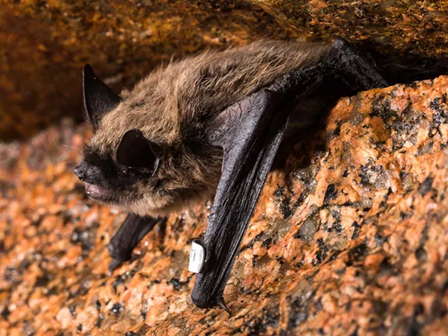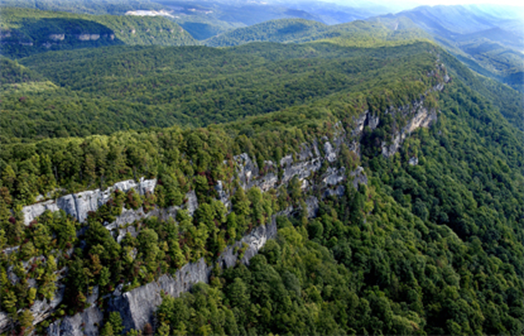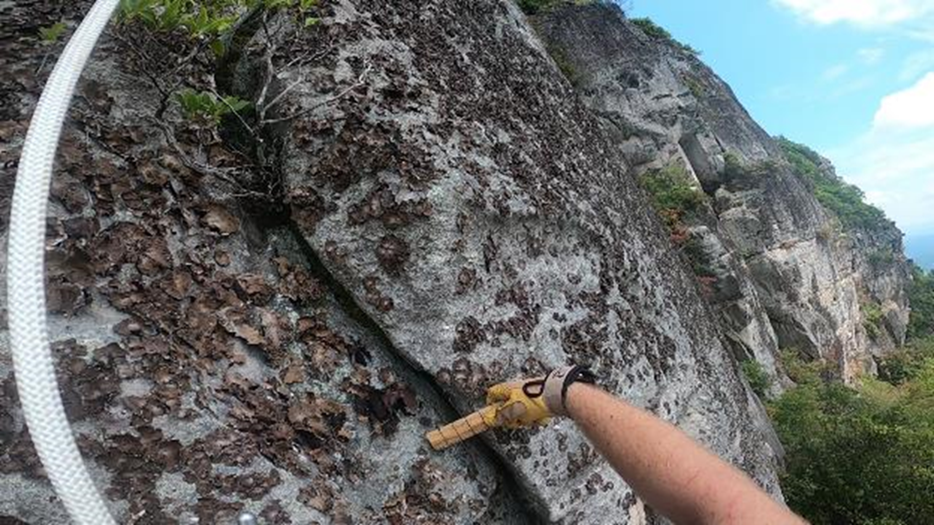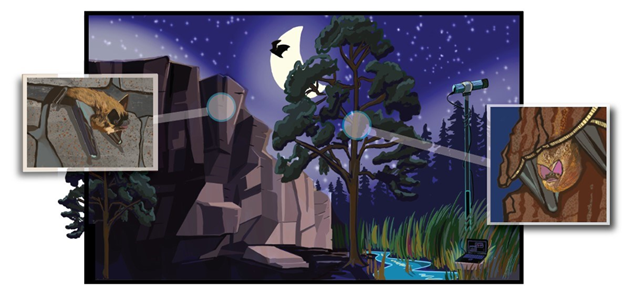Last updated: March 1, 2024
Article
Bats and Rats at Cumberland Gap: Inventories Inform Management Decisions

White Rocks, Cumberland Gap National Historical Park. NPS/Scott Teodorski.
Background
At Cumberland Gap National Historical Park, the towering White Rocks have stood as a visual landmark for travelers across history. A popular trail leads hikers and equestrians to the top, and beyond. Backcountry campers can enjoy a site near White Rocks, as well.
In recent years, the park has received requests to open the area to climbing. But before park managers could make that decision, they needed information on the potential impacts of climbing on natural and cultural resources. That included knowing whether the cliffs are used by at-risk wildlife species.
In response, the NPS Inventory Program funded a survey at White Rocks to look for the presence of two at-risk species (those listed under the Endangered Species Act or considered to be of special management concern because they are rare, declining, sensitive, or unique): the Allegheny woodrat (Neotoma magister) and the eastern small-footed bat (Myotis leibii).
Bats and rats are often-misunderstood but essential parts of their ecosystems. Bats that live in caves bring in nutrients that help support unique, cave-dwelling fish, salamanders, and other creatures. Bats that eat nectar pollinate the flowers of agave, giant cacti, and several other plants. Bats that eat insects, such as the eastern small-footed bat, can eat their weight in insects every night. In the U.S., millions of insect-eating bats eat literally tons of insects every night, leaving fewer mosquitoes to spread diseases and fewer pests to damage crops. Woodrats are a vital source of food for great horned owls, bobcats, and many other animals. They also help create new habitats by spreading seeds and building “houses” that other animals use for shelter.
What are Allegheny Woodrats?
While they might look somewhat similar to the common Norway rat (Rattus norvegicus), Allegheny woodrats are native to North America and are actually a far different creature (Figure 1). Also known as packrats, Allegheny woodrats are primarily solitary creatures with long whiskers and hairy tails. They live in the rocky woodlands of eastern North America, from southern Canada south to Alabama and Georgia. However, their population has diminished across much of their original range, and they are locally extinct in parts of many states, including Connecticut, Massachusetts, New York, parts of Pennsylvania, New Jersey, and Maryland (NPS 2021). As a result, they are a species of concern, and their populations are carefully monitored.

Figure 1. An Allegheny woodrat (Neotoma magister) and its youngster. Photo by Alan Cressler, licensed under CC BY-SA 2.0.
What are Eastern Small-footed Bats?
Little is known about the habits of the eastern small-footed bat. This tiny, 3-inch-long bat lives across the eastern United States and southern Canada. Yet they are considered uncommon or rare because of their patchy distribution and generally low population numbers (USFWS 2013). They are listed as a threatened species in Kentucky, where human disturbance is a potential threat at more than half of the known eastern small-footed bat hibernacula (a site where one or more bats hibernate). Modification or destruction of habitat, human disturbance, and climate change are also potential threats. (USFWS 2013, KDFWR 2023). Eastern small-footed bats roost during the day and are active at night. While little is known about their home range, they are thought to live in a small area but have many roosting sites. They hunt insects by using echolocation and are successful hunters in dense forest areas, such as that at the base of White Rocks. They hibernate in the winter and occupy crevices and fissures during the summer months (Figure 2).

Figure 2. An eastern small-footed bat (Myotis leibii) peeks out from a crevice in Shenandoah National Park, Virginia. Note that the bat has a tag to help with tracking its travels. Photo by NPS/Jonathan Fiely.
Habitat at Cumberland Gap
The cliffs and forests at White Rocks (Figure 3) offer ideal habitat for eastern small-footed bats and Allegheny woodrats. Both species prefer rocky ledges and outcrops, or cracks and crevices, surrounded by forest habitat.

Figure 3. An aerial view of White Rocks, Cumberland Gap National Historical Park. The cliff face is prime habitat for both Allegheny woodrats and eastern small-footed bats. NPS photo.
While both species inhabit similar environments, they use them in different ways. The eastern small-footed bat uses areas like White Rocks mostly for roosting in the summer, whereas the Allegheny woodrat remains year-round. Bats prefer deep, tight crevices and cracks in cliff faces and can access hard-to-reach places from the air. Woodrats need a bit more space in cracks, and fissures large enough to build nests or cache food in. White Rocks provides a variety of habitat areas for both species.
The Search for Rats and Bats
In the late summer and early fall of 2021, a survey was conducted at White Rocks to look for the presence of both species. Surveys focused on areas that might be considered for climbing routes in the future.
Because both species are primarily nocturnal, roosting or nesting in fissures and cracks during the day, they are difficult to find. Additionally, their habits are very different. As a result, the research team had to get creative. They started with a visual inspection for evidence of both species at eight sites (Figure 4). Researchers rappelled down the cliff face, investigating each crack, crevice, and fissure and looking for signs of bat roosts and evidence of woodrat nests, latrines, and caches of food. Though park staff suspected that woodrats and small-footed bats were present, the visual inspection came up empty.
 Figure 4. Example of the visual search for eastern small-footed bats in a crevice on White Rocks. It was difficult for the researchers to see into such tiny crevices. NPS/Wildlife Specialists.
Figure 4. Example of the visual search for eastern small-footed bats in a crevice on White Rocks. It was difficult for the researchers to see into such tiny crevices. NPS/Wildlife Specialists.
Next, the team broke out more advanced scientific equipment to help in the search. Eastern small-footed bats are tiny, and finding them in cracks, crevices, and fissures is extremely difficult. Therefore, the best bet for identifying the presence of the bats was to find them by sound. The team set up acoustic detectors at both the top of the cliff and at several locations along its base (Figure 5). The devices listened for the distinctive ultrasonic frequencies made by bats as they flew by. The data were recorded and analyzed to pick out the distinctive sounds made by each bat species.

Figure 5. Bats emerge from their roosts (depicted at left and right) to feed at night. The main image shows an acoustic recorder aimed at recording their calls as they fly by. Illustration adapted from NPS/Jen Strona.
For the Allegheny woodrats, the team used baited infrared camera traps to capture images of any creature that ambled by. The camera traps were placed in crevices and rock overhangs in various locations at the base and rim of the cliff.
Findings
Results from the cameras and acoustic detectors demonstrated that both species were present in the surveyed areas. The woodrats showed up each night at the cameras (Figure 6). In fact, many other species enjoyed the peanut butter suet cake bait too—mice, shrews, opossums, chipmunks, raccoons, flying squirrels, and bears. While no nests, latrines, or caches were observed, the woodrats were certainly in the area, indicating they likely live nearby. On the first night of recording, only 40% of the cameras recorded woodrats, but they began to visit the traps more and more on successive nights.
 Figure 6. We see you! A surprised-looking Allegheny woodrat was "trapped" on camera, providing evidence that the species is found at White Rocks. NPS/Wildlife Specialists.
Figure 6. We see you! A surprised-looking Allegheny woodrat was "trapped" on camera, providing evidence that the species is found at White Rocks. NPS/Wildlife Specialists.
While the camera traps showed Allegheny woodrats were present in the area, this type of sampling doesn’t allow researchers to find out how many woodrats live there. So, researchers were unable to draw any conclusions about the size of the population.
As for the acoustic surveys, the devices recorded thousands of calls from bats passing by. A small percentage (less than 1%) were positively identified as those of eastern small-footed bats, with computer software classifying 371 instances of their unique vocalizations. After full analysis, eastern small-footed bats were positively identified at 12 of the acoustic stations, mostly at the base of the cliff.
Conclusions
The results of acoustic monitoring and camera-trap surveys demonstrated the presence of both Allegheny woodrats and eastern small-footed bats in the vicinity of areas that might be considered for future climbing routes. Without identifying roosting or nesting locations that should be safeguarded, the best option for protecting both species is to minimize the amount of potential exposure and contact between humans and these at-risk species.
The presence of both Allegheny woodrats and eastern small-footed bats demonstrates that the park has suitable habitat for bat use and woodrat nesting—an encouraging sign for these species. It also necessitates careful evaluation of any proposed changes to recreational use of the White Rocks area. While little research exists about the effects of rock climbing on bats and woodrats, climbing activities have the potential to negatively impact both species. Direct actions, such as the use and scrubbing of possible roosting locations for footholds and handholds, the degradation of the cliff face from ropes and chalk, and vegetation removal, could impact both species. The presence, noise, and physical interaction of humans with the cliff face and base may also increase stress in individual animals.
Because the sampling focused on areas of the cliff that might be considered for climbing routes in the future, these results apply only to those areas.
Future Research and Recommendations
Data from this survey project have given park staff a better understanding of these two elusive species and important information for evaluating appropriate ways for visitors to enjoy White Rocks without impacting at-risk species. The park staff hopes to continue research on both species, and now has acoustic devices and trail cameras it may use to supplement and refine what we know about Allegheny woodrats and eastern small-footed bats in the park. Long-term monitoring would provide information to help protect both species.
National Park Service managers are required by law to protect at-risk wildlife species in parks. Because these species are struggling, it’s important for visitors and park staff alike to avoid or reduce impacts to important habitat. If park managers decide to allow climbing in the future, measures to help avoid or reduce impacts to bats and woodrats might include:
- Additional research to better understand where the woodrats and small-footed bats are living and how they are using this habitat.
- Seasonal or permanent climbing restrictions to avoid sensitive locations and times for raising young and roosting.
- Control of practices associated with rock climbing that degrade the cliff face (i.e., scrubbing of hand holds or removal of vegetation).
- Signs or other information to increase awareness about and reduce impacts to bats and woodrats.
Literature Cited
Kentucky Department of Fish and Wildlife Resources (KDFWE). 2023. Eastern small-footed myotis.
National Park Service (NPS). 2021. Mammals. Mammoth Cave National Park, Kentucky.
US Fish and Wildlife Service (USFWS). 2013. Endangered and threatened wildlife and plants: 12-month finding on a petition to list the eastern small-footed bat and the northern long-eared bat as endangered or threatened species; listing the northern long-eared bat as an endangered species. Federal Register 78(191):61046-61080.
Additional Sources
Abad, W., J. Morales-Doo, C. Pomeroy, and A. Ung. 2020. Factors affecting woodrat abundance over 70 years. Natural Reserve System, University of California.
Arizona-Sonora Desert Museum. 2017. Desert Diaries. Packrats! What are they good for? Absolutely everything.
Boyles, J.G., P.M. Cryan, G.F. McCracken, and T.H. Kunz. 2011. Economic importance of bats in agriculture. Science 332(6025):41-42.
National Park Service. 2022. At-risk species.
US Forest Service. Eastern small-footed myotis. Accessed June 6, 2023.
Want to Learn More?
Learn more about Allegheny woodrats in our national parks by visiting:
- Allegheny Woodrat: Video (U.S. National Park Service) (nps.gov)
- Allegheny Woodrat - New River Gorge National Park & Preserve
- Vulnerable Allegheny woodrat found in Harpers Ferry National Historical Park for first time in twenty years - Harpers Ferry National Historical Park
- Mammals - Mammoth Cave National Park
- Allegheny Woodrat Monitoring
Learn more about eastern small-footed bats in our national parks at:
- Bats - Acadia National Park. This page provides links to many great NPS articles about bats. Look into the lives of not only eastern small-footed bats, but many other bats species too!
- Bat Species in Parks - Bats
- Bats - Mammoth Cave National Park
- Bat Population Monitoring in Shenandoah National Park
